Não construído
Proposta para o Parque Augusta
Nota
Este projeto foi feito em 2013, em um momento em que uma solução "amigável", conciliadora, que permitiria manter o parque e também permitir a entrada de uma empresa gerenciadora, nos parecia uma excelente saída. Hoje (2015) o parque virou um símbolo da resistência da população contre a apropriação da cidade pelas grandes construtoras, e não temos mais a mesma opinião.
Note
This project was made in 2013, at a time when a "friendly" and conciliatory solution, that would maintain the park and allow the actuation of a managing firm, seemed a very good way to solve the question. Today (2015), the park has become a symbol of the resistance of the population against the appropriation of the city by the big construction firms, and we don't have the same opinion anymore.
Esta é uma proposta para um terreno muito controverso em São Paulo, conhecido como “parque Augusta”. Esta proposta não foi pedida por ninguém, nem é destinada a ninguém. É apenas uma visão nossa, uma reflexão que compartilhamos.
Existem grandes interesses comerciais e corporativos em cima desse terreno, por causa do seu tamanho e da sua excelente localização (próximo ao centro, próximo à rua Augusta, próximo à avenida Paulista). Do outro lado, existe um movimento popular já bem organizado tentando transformar esta área em parque público.
This is a proposal for a very controversed terrain in São Paulo, known as "parque Augusta". This proposal was not ordered by anybody, nor is it aimed at anybody. It is only our vision of the issue, that we decided to share.
Heavy commercial and corporative interests exist on top of this terrain, because of its size and its excellent location (close to the center, close to Augusta st., close to Paulista avenue). On the other side, an already well organized popular movement is trying to convert this space into a public park.
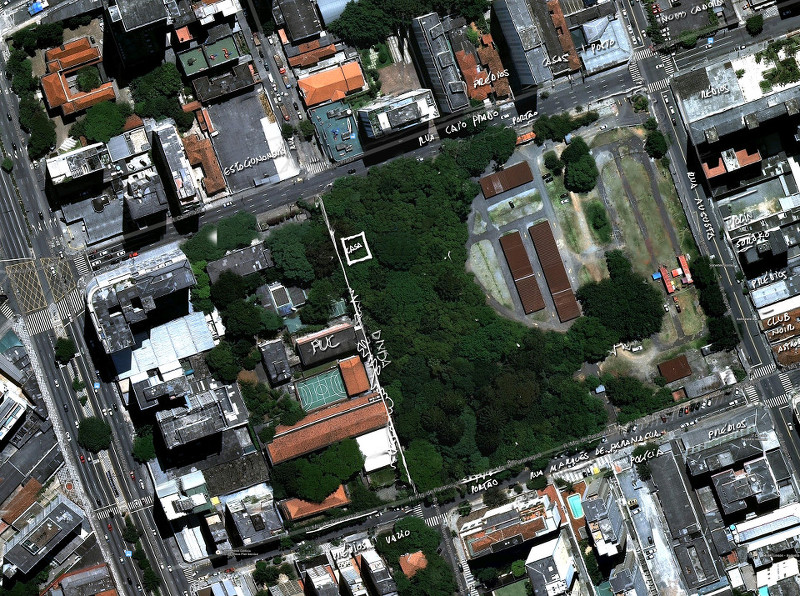
A briga por esse terreno já é bem antiga, no blog acima e nos outros sites por ele indicados tem bastante material sobre o assunto. Aqui está o que pensamos a respeito:
- O terreno tem uma enorme área coberta com árvores antigas, que deve sem nenhuma dúvida ser preservada. Um pedaço de “mata” como esse em pleno centro de São Paulo é valioso demais para a cidade e por isso deve ser utilizado por todos.
- Confiar em alguma empresa para proteger essa área é altamente arriscado, mesmo obrigando-a a proteger a vegetação (o que já é o caso). É muito fácil eles contornarem a lei e removerem pedacinhos “acidentalmente”, sobretudo visto que cada metro quadrado construível tem um valor muito alto.
- A localização é boa para empreendimentos imobiliários, mas não muito boa para um parque. A razão principal é que tem muito poucas pessoas circulando em volta dele, pouco comércio e ruas quase desertas (fora a rua Augusta, claro).
- Já existem vários espaços públicos muito bons muito próximos (praça Roosevelt, praça Dom José Gaspar). A praça Roosevelt recentemente passou por uma reforma que achamos exemplar, e o risco é muito alto de prejudicar a nova vida dela.
- Querer que a prefeitura assuma (desaproprie) o terreno para que ele vire um parque não nos parece muito sustentável… Cada vez que temos um problema na cidade vamos precisar da intervenção divina do prefeito? Um pedaço de cidade deveria poder evoluir no bom sentido sem precisar de uma operação médica para mantê-lo vivo.
- O principal problema das empresas é que enxergam esse terreno como uma montanha de dinheiro. Elas pensam: “imaginem quantos mil metros quadrados poderíamos construir ali”. Portanto, ninguém está interessado em construir algo pequeno. “Porque se contentar com uns trocados quando se pode obter milhões?” Agora, se o tamanho máximo de construção fosse fixado por lei em algo muito baixo (por exemplo, que se possa construir em até 20% do terreno), o máximo possível não seria mais esses “milhões”, e esses “trocados” não pareceriam assim tão pouco…
- Todo o “fundo” do terreno é um campus da PUC. Um acesso entre a PUC e o terreno permitiria que as pessoas pudessem atravessar até a avenida da Consolação, o que mudaria muito a situação, e um parque começaria a se tornar viável.
The figh around this terrain is not new, on the blog linked above and other sites it links to, you can find a lot of material over the subject. This is what we think about it:
- A huge part of the terrain is covered with old trees, that must without any doubt be preserved. A piece of "forest" like that in the middle of São Paulo has an enormous value for the city, and should be used by all.
- To trust a real estate company with the protection of this area is highly risky, even forcing it to protect the vegetation (which is the case already). It is very easy for them to circumvent the law and "accidentally" remove pieces of it, especially considering the high commercial value of each buildable square meter.
- The localization is good for real estate business, but not too good for a park. The main reason being that there are very few people circulating in that area, few shops, and pretty empty streets (excepting Augusta st., obviously).
- There are several very good public spaces very close (praça Roosevelt, praça Dom José Gaspar). Roosevelt square recently went through an upgrade that we found remarkable, and there is a high risk to harm its fragile new life.
- To ask to the city authorities to take control (expropriate) the terrain so it becomes a park doesn't seem very sustainable to us... Each time we have a problem in the city, will we need the mayor's divine intervention? A piece of city should be able to evolve in the right direction without a medical operation to keep it alive.
- The main problem with real-estate firms is that they see the terrain as a big pot of money. They think: "imagine how many square meters we could build there". Therefore, nobody wants to build small. "Why should we content ourselves with a few coins when we could get millions?". But if the maximum construction size would be fixed by law to something rather low (for example, you can only build on 20% of the area), the maximum would not be those millions anymore, and the "few coins" wouldn't look so small anymore...
- All the "back" of the terrain is a campus of the PUC university. If there were an access between the PUC and the terrain, it would allow people to cross and reach Consolação avenue, which would change the situation a lot, and a park would begin to become viable.
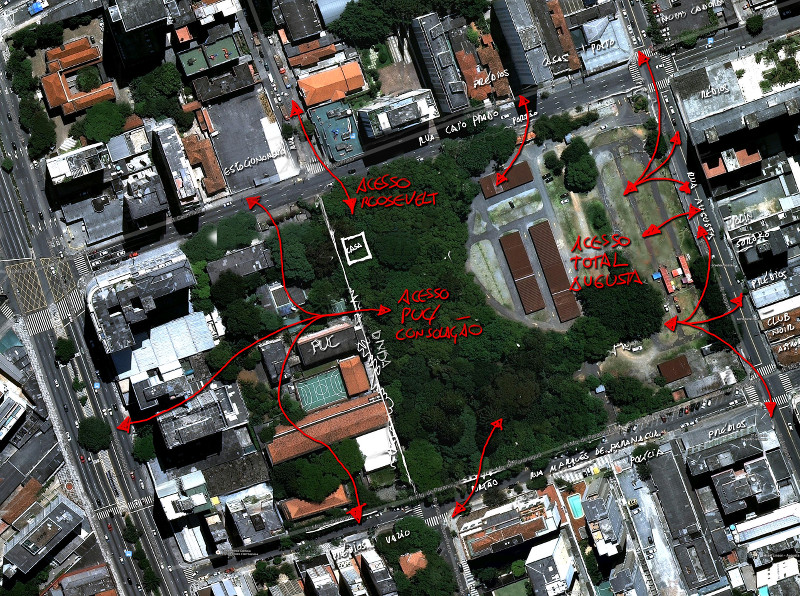
Esta proposta nossa é baseada nisso tudo. Pensamos que essa área deve sim virar um parque, e deve ser público. Mas também deve “se virar sozinho” e ser bem diferente da praça Roosevelt, para não competir com ela.
Em uma alternativa intermediária, propomos dividir: destinamos uma área (tracejado vermelho abaixo), de 25 metros de largura, junto à rua Augusta, deixando uma calçada bem larga. Somente nessa área seria possível construir – desde que se mantenha uma permeabilidade de pedestres entre a rua Augusta e a área verde -, permitindo uma ou outra exceção, por exemplo, para alguma função que não coubesse em 25 metros, como uma sala de espetáculo ou um cinema. Os blocos construídos poderiam conter qualquer coisa, ter qualquer forma, e seriam baixos (no máximo 3 ou 4 andares).
Our proposal is based on all this. We think this area should become a park indeed,and should be public. But it should also be able to "go on its own legs" and be very different than the Roosevelt square, so they don't compete.
We propose to divide: one area is reserved (the red dashed line below), 25 meters wide, along Augusta street, leaving a large sidewalk. Only in this area is it possible to build, allowing one or another exception, for example for some function that would not fit in 25 meters, such as a theatre. The built blocks can house anything, and have any form, and would be low (maximum 3 or 4 floors).
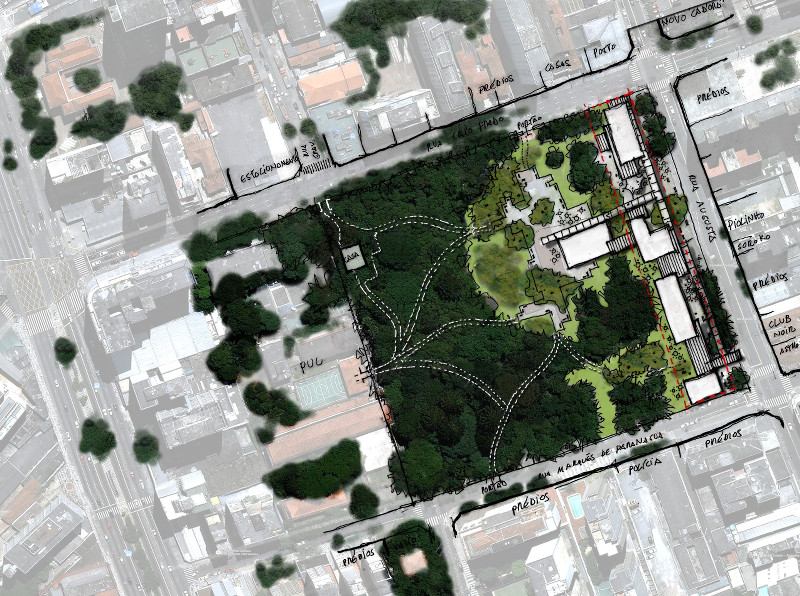
O verde escuro, no desenho acima, é a vegetação existente. O verde claro seria complementado, e permitiria fazer várias experiências ecológicas. O impacto construído seria mínimo, mas suficiente para gerar renda, para que alguma empresa decida construir o projeto. Shopping malls com este tamanho existem em todo lugar, o que prova que pode ser lucrativo sim.
The dark green color, in the above drawing, is the existing vegetation. The light green color would be complmented, allowing for diverse ecological experiments. The built impact would be minimal, but suficient to provide financial income, to decide a corporation to build the project. Shopping malls of this size exist everywhere, proving that it can be lucrative enough for the purpose.
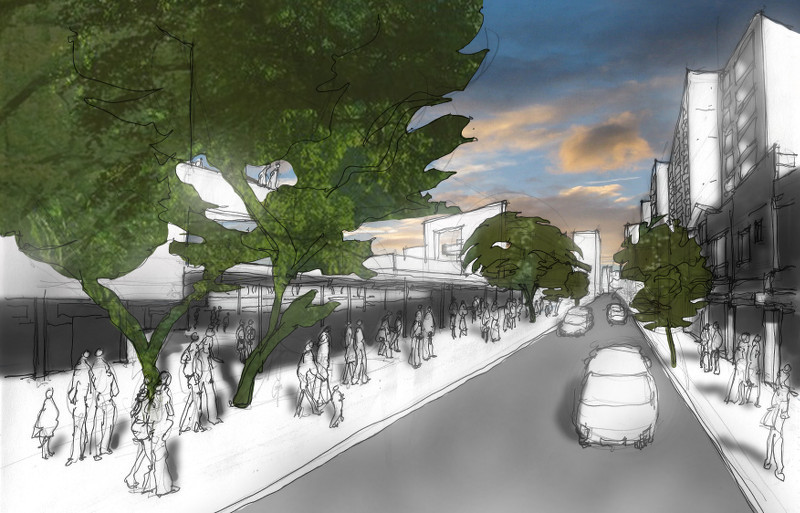
Provavelmente São Paulo não precisa de mais um shopping mall, portanto imaginamos algo mais complexo: uma mistura, um empilhamento de todo tipo de funções: Uma maioria de lojas, claro (é dali que viria a renda do empreendedor, e a rua Augusta é uma rua muito comercial), mas ali também poderiam caber hubs (como este), oficinas e salas no estilo da Casa de Cultura Digital, uma creche ou escolinha (existia uma quase em frente, que foi demolida), uma sala de espetáculos/auditório/cinema que possa ser alugada (aparentemente essas salas fazem muita falta em São Paulo), ou qualquer atividade pública que a prefeitura possa querer colocar na região (caso eles se empolguem tanto que queiram participar do projeto, quem sabe).
O importante é que sejam funções que tragam pessoas para o parque e ao mesmo tempo se beneficiem das pessoas que estiverem lá, criando uma sinergia entre a parte de parque e a parte construída. Essa é a justificativa principal dessa proposta.
Probably does São Paulo not need one more shopping mall, therefore we imagined something more complex: A mix, a stacking of all kinds of functions: A biggest part of shops, of course (it is from there that the income of the investor would come, and Augusta st. is already pretty commercial), but other things could also fit there, like hubs (like this), workshops and offices like the Casa de Cultura Digital, a nursery or kindergarten (there was one in front of the terrain, that got demolished), a theatre/auditorium/movies theatre that could be rented (apparently spaces like that are sparse in São Paulo) or any other public activity that the city authorities might want to put in that region (in case they get so excited by this proposal that they want to participate, you never know)
The important part is that they would be functions that bring people to the park and at the same time get supported by the people who are there, creating a synergy between the park part and the built part. This is the main justification of this proposal.
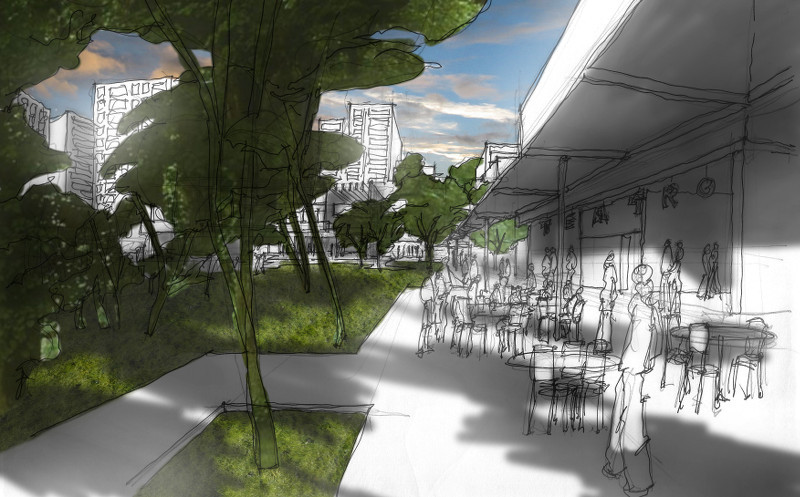
Essa proposta certamente não tem nada de revolucionário. Aliás, é uma solução bastante simples e comum. Mas às vezes elas funcionam muito bem...
Existem certamente muitas outras ideias diferentes. Um presente bem legal para esse terreno, seria um concurso de arquitetura, onde todos pudessem propor ideias. Com certeza, soluções muitíssimo interessantes sairiam de lá.
This proposal surely has nothing revolutionary. Actually, it is even a pretty simples and common solution. But in some case those work very well...
But certainly many different ideas exist. A nice present for this terrain would be an architecture competition, where everyone could propose ideas. Surely, very interesting solutions would arise from there.
Este projeto é de código aberto. Os arquivos estão disponíveis no nosso github.
This project is open-source. Files are available on our github.





